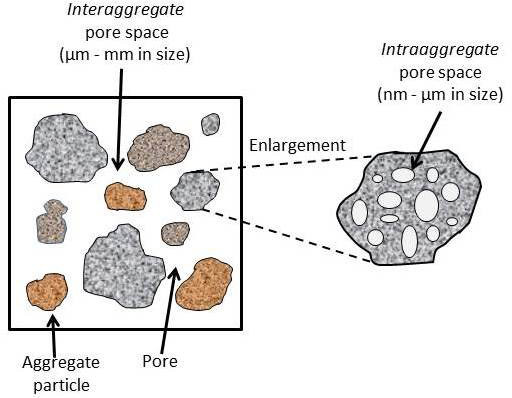土壌中の水分の定量
概要
ソース: ドクターペッパー イアン博士チャールズ Gerba - アリゾナ大学所
示す著者: ブラッドリー ・ シュミッツ
土壌は通常「土壌含水率」として表現することができます水の有限な量を含む土壌団粒 (骨材間の気孔スペース) の間に空隙内および土壌団粒 (内集計気孔スペース) 内で、この水分が存在する (図 1)。通常この気孔スペースは、空気や水によって占められています。すべての毛穴が空気によって占有されて、土は完全に乾燥です。すべての毛穴には水が入り、土は飽和するといいます。

図 1。土の気孔スペース。
原則
屋外の自然環境に水は、降雨や植物の意図的な灌漑によって土壌に追加されます。いずれにしても、土壌水分はにつれてより毛穴が空気を犠牲にして水でいっぱいになった。すべての毛穴が水でいっぱいになって、余分な水分は雨または潅漑の消滅まで下方 (図 2) 継続的な土壌の気孔を通してを濾す今。溶出は、孔内水膜は、重力の力に対して土壌コロイドの表面張力によって保持されてまで続行されます。このような状況は、土壌水分に関して「容量のフィールド」で土壌と呼ばれます。フィールドの容量で土壌には土壌水分の膜に囲まれた、空気で満たされて毛穴。通常フィールドの容量で土壌は空気と水の両方が使用できるので、植物の成長と好気性土壌微生物に最適です。一方、飽和土は植物を殺すことができ刺激的な嫌気性微生物中の好気性土壌微生物を抑制する水浸しの嫌気的条件を作成します。

図 2。土壌に溶出する栄養素。
ビーカーなどのコンテナー内にある湿った土のサンプルを検討してください。湿った土の重量は、乾燥した土粒子の重量に加えて、土壌内の水の重量で構成されています。土により多くの水を追加すると、土の湿潤重量は増加します。サンプル内の土壌粒子の乾燥重量は、すなわち、1 つの重量は乾燥重量である固定されています。対照的に、土にどのくらいの水を加えに応じてウェットの重みの無限の数があります。このため、土壌、実験演習を行うとき土の含水率は、乾燥重量は一定時間、湿った、またはぬれた重量を時間をかけて変更できますので乾燥重量ベースで、通常表されます。土壌の栄養成分など実験の結果を表現する、乾燥重量ベースの使用は、最終結果の標準化を提供します。
手順
- アルミ皿の両方の重量を量る。
- 各アルミに湿った土の約 50 の約数 g 皿し、皿の reweigh。したがって、土壌試料の湿潤重量は今知られています。
- 105 ° C のオーブンで一晩土壌を乾燥させます。
- お皿をオーブンから取り出し、冷ます。
- Reweigh 料理プラス オーブン乾燥した土壌。今乾燥土の重量が知られています。
結果
次の方程式を使用してレプリケーションのサンプルのそれぞれの土壌水分量を計算します。
% の含水率 (MC) =
(乾燥重量ベース)
計算例:
M = 102 g
D = 90 g
∴ %MC =
MC = 13.3%
5 g の水、新しい M の追加 = 107 と D まだ等しい 90
∴ %MC =
新しい MC = 18.9%
申請書と概要
乾燥重量ベースで土壌の含水率の知識は、いくつかの方法で便利です。たとえば、実験はアンモニウム肥料 (たとえば 50 μ g/g) の濃度既知と改正すべき土で行われている場合その乾燥重量ベースで含水率を決定する必要があります。湿重量に基づいて計算を完了すると、追加する肥料の量が含水率 (および湿った重量) 土壌試料の上依存でしょう。同様に、鉢植えの植物がある場合含水率知られていなければならない土壌があまりにもではないことを確認するために (植物成長のため十分な水分) を乾燥またはあまりにもウェット (湛水と嫌気性)。フィールド状況土壌含水率の知識は、過剰なかんがいと土壌養分の溶脱を防ぐことができます。
タグ
スキップ先...
このコレクションのビデオ:

Now Playing
土壌中の水分の定量
Environmental Microbiology
359.6K 閲覧数

無菌環境科学
Environmental Microbiology
126.5K 閲覧数

環境ソースから細菌のグラム染色
Environmental Microbiology
100.4K 閲覧数

連絡先を介して可視化の土壌微生物スライド法と顕微鏡
Environmental Microbiology
42.3K 閲覧数

糸状菌
Environmental Microbiology
57.4K 閲覧数

細菌のコロニーからコミュニティの DNA の抽出
Environmental Microbiology
28.9K 閲覧数

ポリメラーゼ連鎖反応およびゲル電気泳動法と環境微生物の検出
Environmental Microbiology
44.6K 閲覧数

RT-PCR 法を用いた環境試料の RNA 解析
Environmental Microbiology
40.4K 閲覧数

環境微生物やウイルスを使用しての qPCR の定量化
Environmental Microbiology
47.9K 閲覧数

指標生物による水質分析
Environmental Microbiology
29.6K 閲覧数

ろ過による水試料からの糞便細菌の分離
Environmental Microbiology
39.4K 閲覧数

環境試料中のバクテリオファージの検出
Environmental Microbiology
40.8K 閲覧数

養殖および土壌試料からの細菌を列挙します。
Environmental Microbiology
184.6K 閲覧数

細菌の成長曲線の解析と環境応用
Environmental Microbiology
296.1K 閲覧数

藻類培養手法を介して列挙
Environmental Microbiology
13.8K 閲覧数
Copyright © 2023 MyJoVE Corporation. All rights reserved